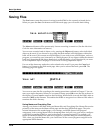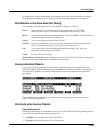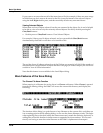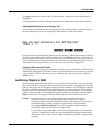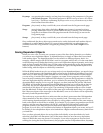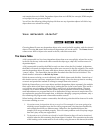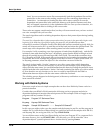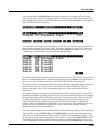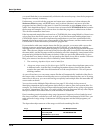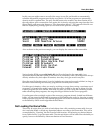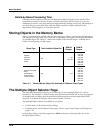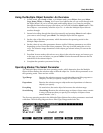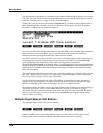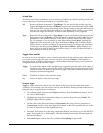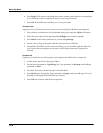
13-32
Basic Disk Mode
Saving Files
you would find that it was automatically relinked to the correct keymap, since the keymaps and
samples are currently in memory.
Furthermore, you could edit the program and create more variations of it that reference the
Steinwave Piano keymap, add ROM layers, and/or effects if desired, and resave all of the
programs (and any effects) to the same or a new file (remember to press Names when you are
asked “Save dependent objects?”) You never have to resave the file STWAVE1.K26 that contains
the keymap and samples, if all you have done is edited the programs or added more of them.
This can be a tremendous time-saver.
If the keymap and sample files are found on a CD-ROM disk, then using Relink-by-Name is not
only a time-saver, but a disk-space saver as well. If you like the samples and keymaps from a
CD-ROM file, there is no need to duplicate the sample data on your own writable hard disk.
Instead, all you have to do is save a program file in the above manner, and then make sure the
CD-ROM file is loaded first before you load the program file.
If you needed to add some sample data to the file (for example, you want to add a root to the
keymap or process and reloop a sample from the CD-ROM), you can do this by explicitly
selecting the new sample data and the keymap for saving along with the program and the name
table. Then, the new sample would not be listed in the name table (it would be in the same file as
the name table), and the keymap would be relinked to all of the samples by name instead of the
program being relinked to the keymap (as before). What you put in the different files is up to
you, and there is no limit to where you can break up the objects in one file or another. The main
thing to be aware of are the two rules for Relink-by-name mentioned above:
1. Files containing dependent objects must be loaded first.
2. Always use unique names for like objects types. (NOTE: In cases where duplicate names exist
in different banks, load the file(s) containing dependent objects, then load the file that
contains the name table into the same bank or to the one just before it. This will prevent
relinking conflicts.
As you will see later, you can create a macro file that will automatically load both of the files in
the correct order, no matter what disks they are on or what disk directories they are in. By using
macro files in this way, you can avoid having to explicitly load multiple files and remember the
correct order each time.
You can also use the Multiple Object Selector (see page 13-34) to help in the process of
identifying dependent objects and parent objects that you want to place into separate files. For
example, you could easily select all dependent keymaps and samples of any group of programs,
to create a “dependents” file. Then, you could quickly select the programs and any other objects
that you wanted to be relinked later on, and save them in another file.
Here is another practical example using songs (sequences). Suppose you have loaded several
files into your K2661, such that you now have all your favorite instruments in RAM. Then, you
make a bunch of songs using a combination of ROM programs and the RAM programs you
loaded.
The dependent object structure of the songs would look something like this:
Songs 400 Wild Jam 401 Memphis Groove
Programs 600 Drawbarz
231 Funky GTR
50 Studio Kit 1 (from ROM)
245 FendJazzBass
400 ObieWarble Pad
Effects ROM Effects
Keymaps, Samples Lots of ‘em…



